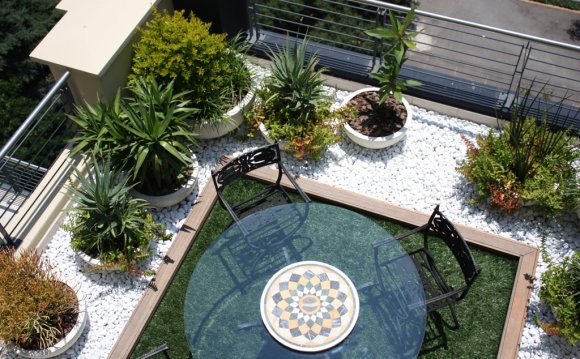
 Rooftop Garden Design Tips
Rooftop Garden Design Tips
Use this infographic to learn about garden design on rooftops and balconies. Discover four design constraints that are unique to rooftops and see examples of successful designs. Plus get and list of plants and vegetables suited for rooftop conditions. Also see your container and paving material options.
Rooftop Garden Tips (PDF)
Creating a personal outdoor living space on your rooftop, terrace or balcony provides a place to go outdoors for welcome relief from the hustle of high density urban living. Good design can bring precious additional living space to small condos and apartments. These landscapes are different from anywhere else because they are elevated, from a few feet to many stories above the earth. They are also on-structure, which necessitates many unique requirements to ensure you project is buildable, visually appealing and supportive of green plants.
1. Preserve the ViewThe view from a rooftop living space is your most valuable amenity, so all design decisions must preserve and maximize it. Solving practical problems must be done in a way that does not diminish the view. For example, changing a solid wall to a transparent wrought iron railing can greatly enhance the view, and borrow space to make your project seem larger. But if there's an eyesore, replacing a transparent rail with a solid wall may be the perfect solution for retaining the view while screening this undesirable segment.
Load Consciousness
Buildings that offer residential balconies and terraces vary considerably in age, architecture and structural reinforcement. Your designer will be very conscious of how much weight your project will place upon the load bearing surfaces. The older the building the less weight the structure can support. For an extensive project, be prepared to budget an engineer's structural analysis and other requirements that may be required by the building owner or the city.
2. Enhance PrivacyOften balconies are constructed to serve many units, not just yours. To create a private space for relaxation, screening off your neighbors can be paramount. Keep in mind that all solid partitions will influence air movement. This may be a good thing if you have problem wind from that direction, or it can be undesirable in summer when the partition creates stagnant air. This is why partitions are most often made of open material such as lattice or metal grids enhanced with vines. When considering privacy, be aware of your standing privacy needs as well as those when you're sitting down. Discuss this with your designer to find the least imposing solution for privacy while maintaining air movement and view so you don't end up with a potentially claustrophobic space.
3. Mitigate the EnvironmentWhen you invest a lot of money in an outdoor living space, it must be comfortable for you and your plants in as many seasons as possible. In the colder months when you live indoors, the planting and decor should make this space equally as attractive to look at through windows. Your designer's biggest challenge is to put into place elements that mitigate your unique set of climatic challenges with attractive components that work well with your interior style.
Some of the typical problems include west facing units where afternoon heat and full exposure in the summer months can be overwhelming. Here you will need seasonal shade or an umbrella or another creative shade source for you and your plants. Those units located in wind corridors where gales rip through the spaces between large buildings will definitely need protection. Wind screens or selection of plants that tolerate this buffeting may be essential.
4. Furniture: Comfort vs. SizeThe most important commodity in any city is space, where every square inch matters. That's why selecting furniture is so difficult. Big bulky pieces are out, small and well designed is in. Your choice must demand as little square footage as possible without compromising comfort. Strive for a balance of style and versatility. Furniture that blends with that of the adjacent room helps to blend interior and exterior style.
YOU MIGHT ALSO LIKE












